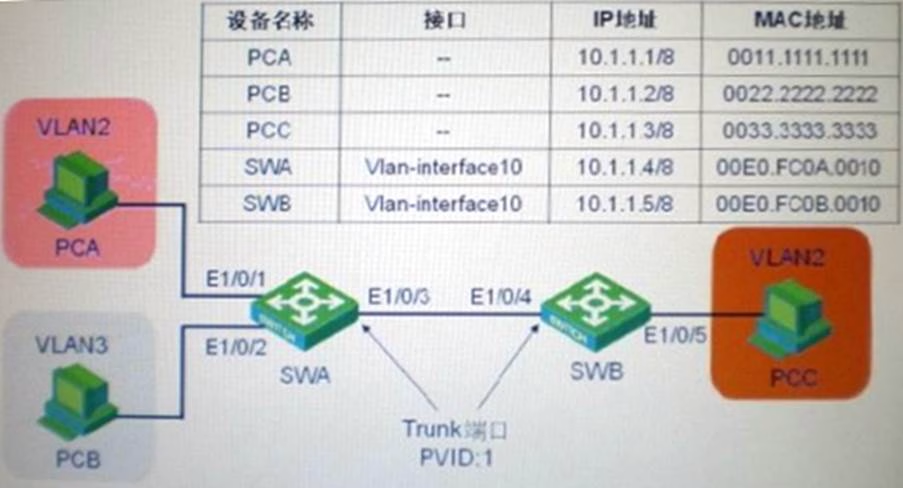In the switching network shown in the figure, VLAN10 is set as Super VLAN on switch SWA, VLAN2 and VLAN3 are sub VLANs of VLAN10, port Ethernet1/0/3 is a Trunk port, PVID is VLAN1, and all VLANs are allowed to pass; VLAN2~VLAN20 are created on switch SWB, port Ethernet1/0/4 is a Trunk port, PVID is VLAN1, and all VLANs are allowed to pass. Check the Ethernet 1/0/3 port information on SWA, which of the following is the correct display?
In the switching network shown in the figure, VLAN10 is set as Super VLAN on switch SWA, VLAN2 and VLAN3 are sub VLANs of VLAN10, port Ethernet1/0/3 is a Trunk port, PVID is VLAN1, and all VLANs are allowed to pass; VLAN2~VLAN20 are created on switch SWB, port Ethernet1/0/4 is a Trunk port, PVID is VLAN1, and all VLANs are allowed to pass. Check the Ethernet 1/0/3 port information on SWA, which of the following is the correct display?

A . [SWA] display interface Ethernet 1/0/3 Ethernet1/0/3 current state: UP
PVID: 1
Mdi type: auto
Link delay is 0 ( sec ) Port link-type: trunk
VLAN passing: 1 ( default vlan ), 2-3 , 10 VLAN permitted: 1 ( default vlan ), 2-4094 Trunk port encapsulation: IEEE 802.1q
B . [SWA] display interface Ethernet 1/0/3 Ethernet1/0/3 current state: UP ……
PVID: 1
Mdi type: auto
Link delay is 0 ( sec ) Port link-type: trunk
VLAN passing: 1 ( default vlan ), 2-3
VLAN permitted: 1 ( default vlan ), 2-9 , 11-4094 Trunk port encapsulation: IEEE 802.1q
C . [SWA] display interface Ethernet 1/0/3 Ethernet1/0/3 current state: UP ……
PVID: 1
Mdi type: auto
Link delay is 0 (sec)Port link-type: trunk
VLAN passing: 1 (default vlan), 2
VLAN permitted: 1 (default vlan), 2-9, 11-4094 Trunk port encapsulation: IEEE 802.1q
D . [SWA] display interface Ethernet 1/0/3 Ethernet1/0/3 current state: UP ……
PVID: 1
Mdi type: auto
Link delay is 0 (sec)Port link-type: trunk
VLAN passing: 1 (default vlan), 2
VLAN permitted: 1 (default vlan), 2-4094
Trunk port encapsulation: IEEE 802.1q
Answer: B
Latest GB0-372-ENU Dumps Valid Version with 432 Q&As
Latest And Valid Q&A | Instant Download | Once Fail, Full Refund

